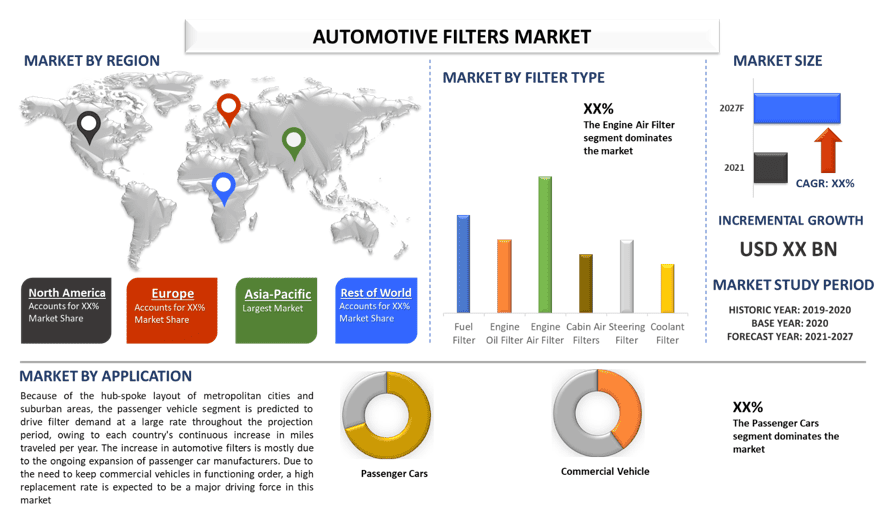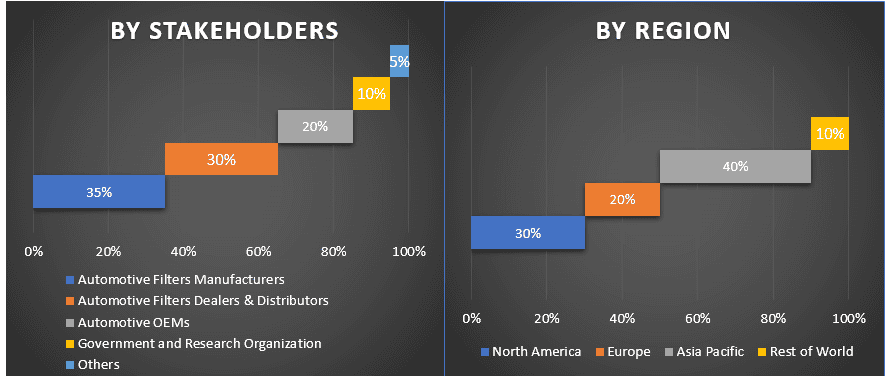
글로벌 자동차 필터는 예측 기간(2021-2027년) 동안 약 ~4%의 연평균 성장률(CAGR)을 보일 것으로 예상됩니다. 자동차 필터 시장은 교체 불가능한 필터가 향후 필터 애프터마켓에 영향을 미칠 것이라는 사실에 의해 제약을 받습니다. 왜냐하면 에어 필터 및 캐빈 필터와 같은 일부 필터는 차량 수명 동안 교체할 필요가 없기 때문입니다. 교체 불가능한 필터 시장은 여전히 활발합니다. 이러한 필터는 교체가 필요 없고 기존 필터에 비해 비용 절감과 같은 여러 가지 이점 때문에 향후 몇 년 동안 강력한 시장을 가질 것으로 예상됩니다. 결과적으로 전기 자동차의 사용 및 생산 증가는 자동차 필터 시장의 성장을 저해하고 있습니다. 또한 자동차 필터 시장은 기술 및 필터 매체의 발전으로 인해 많은 잠재력을 가지고 있습니다. 필터 매체는 필터의 가장 중요한 부분입니다. 그 목적은 원치 않거나 불필요한 입자를 잡는 것입니다. 용도에 따라 일반적으로 셀룰로오스, 합성 섬유, 유리 섬유 및 활성 탄수화물로 구성됩니다. 앞으로 필터 매체 유형 또는 기술의 발전은 자동차 필터 제조업체에게 중요한 기회를 창출할 것입니다.
보고서에 제시된 통찰력
"필터 유형 중에서 엔진 에어 필터 부문이 2020년에 시장을 지배했습니다."
필터 유형에 따라 시장은 연료 필터, 엔진 오일 필터, 엔진 에어 필터, 캐빈 에어 필터, 스티어링 필터 및 냉각수 필터로 분류됩니다. 엔진 에어 필터 부문은 2020년에 XX억 USD의 수익을 창출했으며 예측 기간 동안 연평균 성장률 XX%로 성장할 것으로 예상됩니다. 엔진 에어 필터는 곤충, 먼지, 입자, 모래 및 파편이 엔진에 들어가지 않도록 하고 최적의 효율성을 위해 양호한 공기-연료 혼합을 유지합니다. 엔진은 자동차의 가장 중요한 부분이기 때문에 고객은 엔진이 가능한 한 안전하고 효율적이기를 원합니다. 결과적으로 엔진 에어 필터가 시장을 주도할 것으로 예상됩니다. 깨끗한 자동차 엔진 에어 필터의 이점은 더 나은 성능과 효율성, 엔진 수명 연장, 저렴하고 빠른 교체이며, 이 모든 것이 2021-2027년 예측 기간 동안 이 부문의 성장에 기여합니다.
"응용 분야 중에서 승용차 부문이 2020년에 시장을 지배했습니다."
응용 분야에 따라 시장은 승용차와 상용차로 분류됩니다. 승용차 부문은 2020년에 XX억 USD의 수익을 창출했으며 예측 기간 동안 연평균 성장률 XX%로 성장할 것으로 예상됩니다. 대도시와 교외 지역의 허브-스포크 레이아웃으로 인해 승용차 부문은 각 국가의 연간 주행 거리가 지속적으로 증가함에 따라 예측 기간 동안 필터 수요를 크게 주도할 것으로 예상됩니다. 자동차 필터의 증가는 주로 승용차 제조업체의 지속적인 확장 때문입니다. 상용차를 작동 상태로 유지해야 할 필요성 때문에 높은 교체율이 이 시장의 주요 추진력이 될 것으로 예상됩니다.
"유통 채널 중에서 애프터마켓 부문이 2020년에 시장을 지배했습니다."
유통 채널에 따라 시장은 OEM과 애프터마켓으로 분류됩니다. 애프터마켓 부문은 2020년에 XX억 USD의 수익을 창출했으며 예측 기간 동안 연평균 성장률 XX%로 성장할 것으로 예상됩니다. 자동차 애프터마켓 부품은 OEM 품목보다 간편하게 구할 수 있고 비용이 저렴하기 때문에 수요가 높습니다. OEM 제품은 유사한 기술 사양과 성능을 가진 대안보다 비싸기 때문에 소비자는 유사한 기술 사양과 성능을 가진 대안을 선택할 가능성이 더 큽니다. 또한 전자 상거래를 통해 제품을 쉽게 구할 수 있기 때문에 부품 배송 판매 및 서비스가 증가했습니다.
"아시아 태평양이 가장 큰 시장을 대표합니다."
예측 기간 동안 아시아 태평양 지역은 자동차 필터 시장을 주도했는데, 이는 가처분 소득 증가, 빠른 산업화 및 승용차 판매 증가로 인해 2021년부터 2027년까지 아시아 태평양 자동차 필터 시장이 XX% 이상의 연평균 성장률로 성장할 것으로 예상되기 때문입니다. 앞으로 중국의 높은 자동차 생산량으로 인해 교체 수요가 증가할 것입니다. 애프터마켓 부품 제조에 대한 유리한 FDI 정책과 탄소 배출량 감소를 목표로 하는 정부 규정은 상당한 이익을 가져올 것입니다. 시장에서 활동하는 주요 업체로는 Robert Bosch GmbH, K&N Engineering, Inc, MAHLE GmbH, Donaldson Company, Sogefi S.p.A, Hengst SE, DENSO Corporation, Toyota Boshoku Corporation, Valeo SA, MANN+HUMMEL 등이 있습니다.
이 보고서를 구매해야 하는 이유:
- 이 연구에는 인증된 주요 업계 전문가가 검증한 시장 규모 및 예측 분석이 포함되어 있습니다.
- 이 보고서는 전체 산업 성과에 대한 빠른 검토를 한눈에 제공합니다.
- 이 보고서는 주요 비즈니스 재무, 제품 포트폴리오, 확장 전략 및 최근 개발에 중점을 두고 주요 업계 동료에 대한 심층 분석을 다룹니다.
- 산업 전반에 걸쳐 널리 퍼져 있는 동인, 제약, 주요 추세 및 기회에 대한 자세한 조사
- 이 연구는 다양한 부문에 걸쳐 시장을 포괄적으로 다룹니다.
- 산업에 대한 심층적인 지역 및 국가 수준 분석
맞춤 설정 옵션:
글로벌 자동차 필터는 요구 사항 또는 기타 시장 부문에 따라 추가로 맞춤 설정할 수 있습니다. 이 외에도 UMI는 귀하가 자체적인 비즈니스 요구 사항을 가지고 있을 수 있음을 이해하므로 귀하의 요구 사항에 완벽하게 맞는 보고서를 얻으려면 언제든지 저희에게 연락하십시오.
목차
자동차 필터는 일반적으로 연료 효율과 동력 출력을 높이기 위해 차량에서 먼지 입자와 대기 오염 물질을 제거하는 데 사용됩니다. 이는 공기 흐름을 증가시키고 엔진 손상을 줄여 차량의 수명을 연장하는 데 도움이 됩니다. 자동차 산업에서 광범위하게 응용되고 있습니다. 자동차 필터는 유해한 오염 물질, 불순물 및 독소가 차량에 들어가지 않도록 합니다. 이러한 필터는 난방, 환기 및 에어컨(HVAC) 시스템을 통해 차량에 들어오는 꽃가루, 먼지 입자 및 악취 가스를 포획합니다. 앞유리의 빠른 응결을 방지하여 건강하고 깨끗한 분위기를 유지하면서 시력 문제를 피하는 것이 더 쉬워집니다. 자동차 필터는 엔진 성능을 향상시키고 연료 소비를 줄여 차량의 환경적 영향을 줄이는 전략으로 전 세계적으로 인기를 얻고 있습니다. 여러 국가의 정부는 자동차 판매 증가와 환경 문제 증가의 결과로 온실 가스(GHG) 배출 및 차량 연료 경제에 대한 엄격한 기준을 만들고 있습니다. 결과적으로 탄소 배출량을 줄이기 위해 여러 유형의 필터가 자동차에 점점 더 많이 사용되고 있습니다.
연비가 좋은 디젤 엔진에 대한 소비자 선호도와 탄소 배출량 감소에 대한 필요성으로 인해 차량 필터 시장의 성장이 촉진될 것으로 예상됩니다. 예상 기간 동안 엄격한 정부 배출 규제도 자동차 필터 시장의 성장을 촉진할 것으로 예상됩니다. 미국 환경 보호국에 따르면 2021년부터 2026년까지 승용차 및 경상용차를 대상으로 온실 가스 배출 요건과 기업 평균 연비(CAFE)를 변경하는 제안이 제출되었습니다. 신흥 국가에서 자동차 수가 증가함에 따라 자동차 필터 산업이 성장할 것으로 예상됩니다. 자동차 필터의 혁신 또한 산업 확장에 기여할 것으로 예상됩니다. 자동차 필터 산업은 자동차의 교체 불가능한 필터로 인해 방해를 받을 것으로 예상됩니다. 필터 시장은 대체 연료의 결과로 소비자들 사이에서 전기 자동차 사용이 증가함에 따라 제약을 받을 것으로 예상됩니다. 또한 차량 비용을 줄이는 전기 자동차의 낮은 유지 보수 비용은 전기 자동차에 대한 수요를 촉진할 것으로 예상됩니다.
과거 시장 규모 분석
1단계: 2차 자료 심층 연구:
연간 보고서 및 재무 제표, 성과 발표, 보도 자료 등과 같은 회사 내부 자료와 저널, 뉴스 및 기사, 정부 간행물, 경쟁사 간행물, 부문 보고서, 타사 데이터베이스 및 기타 신뢰할 수 있는 간행물을 포함한 외부 자료를 통해 자동차 필터의 과거 시장 규모를 얻기 위해 상세한 2차 연구를 수행했습니다.
2단계: 시장 세분화:
자동차 필터의 과거 시장 규모를 확보한 후 주요 지역의 다양한 세그먼트 및 하위 세그먼트에 대한 과거 시장 통찰력과 점유율을 수집하기 위해 상세한 2차 분석을 수행했습니다. 보고서에 포함된 주요 세그먼트는 필터 유형, 응용 분야 및 유통 채널입니다. 글로벌 맥락에서 자동차 필터의 전체 채택을 평가하기 위해 추가 지역 및 국가 수준 분석을 수행했습니다.
3단계: 요인 분석:
다양한 세그먼트 및 하위 세그먼트의 과거 시장 규모를 확보한 후 현재 시장 규모를 추정하기 위해 상세한 요인 분석을 수행했습니다. 또한 성장하는 정부 인센티브와 친환경 운송에 대한 수요 등과 같은 종속 변수 및 독립 변수를 사용하여 요인 분석을 수행했습니다. 과거 추세와 시장 규모 및 점유율에 대한 연간 영향이 분석되었습니다. 수요 및 공급측 시나리오도 철저히 연구되었습니다.
현재 시장 규모 추정 및 예측
현재 시장 규모 산정: 위의 3단계에서 얻은 실행 가능한 통찰력을 바탕으로 현재 시장 규모, 시장의 주요 업체, 세그먼트 및 회사의 시장 점유율을 파악했습니다. 필요한 모든 백분율 분할 및 시장 세분화는 위에서 언급한 2차 접근 방식을 사용하여 결정되었으며 1차 인터뷰를 통해 검증되었습니다.
추정 및 예측: 시장 추정 및 예측을 위해 이해 관계자에게 제공되는 동인 및 추세, 제약 및 기회를 포함한 다양한 요인에 가중치가 할당되었습니다. 이러한 요인을 분석한 후 관련 예측 기법, 즉 상향식 접근 방식을 적용하여 주요 지역 전체에서 다양한 세그먼트 및 하위 세그먼트에 대한 2027년까지의 시장 예측에 도달했습니다. 시장 규모를 추정하기 위해 채택된 연구 방법론은 다음과 같습니다.
- 주요 시장에서 가치(미화 달러) 측면의 산업 시장 규모와 자동차 필터 채택률
- 시장 세그먼트 및 하위 세그먼트의 모든 백분율 점유율, 분할 및 세분화
- 제공되는 제품 측면에서 자동차 필터의 주요 업체. 또한 빠르게 성장하는 시장에서 경쟁하기 위해 이러한 업체가 채택한 성장 전략.
시장 규모 및 점유율 검증
1차 연구: 주요 국가의 최고 경영진(CXO/VP, 영업 책임자, 마케팅 책임자, 운영 책임자, 지역 책임자, 국가 책임자 등)을 포함한 핵심 오피니언 리더(KOL)와 심층 인터뷰를 수행했습니다. 그런 다음 1차 연구 결과를 요약하고 언급된 가설을 증명하기 위해 통계 분석을 수행했습니다. 1차 연구의 입력 내용은 2차 결과와 통합되어 정보를 실행 가능한 통찰력으로 전환했습니다.
여러 지역의 1차 참가자 분할

시장 엔지니어링
데이터 삼각 측량 기법을 사용하여 전체 시장 추정을 완료하고 자동차 필터의 각 세그먼트 및 하위 세그먼트에 대한 정확한 통계 수치를 도출했습니다. 데이터는 고도 시스템, 유형, 제품 유형, 구조 및 지역 영역에서 다양한 매개 변수와 추세를 연구한 후 여러 세그먼트 및 하위 세그먼트로 분할되었습니다.
자동차 필터 연구의 주요 목표
자동차 필터의 현재 및 미래 시장 동향이 연구에서 정확히 지적되었습니다. 투자자는 연구에서 수행된 질적 및 양적 분석을 기반으로 투자에 대한 재량을 행사하기 위한 전략적 통찰력을 얻을 수 있습니다. 현재 및 미래 시장 동향은 지역 및 국가 수준에서 시장의 전반적인 매력도를 결정하여 산업 참가자가 미개발 시장을 활용하여 선점자 이점으로 이익을 얻을 수 있는 플랫폼을 제공합니다. 연구의 다른 양적 목표는 다음과 같습니다.
- 가치(미화 달러) 측면에서 자동차 필터의 현재 및 예측 시장 규모를 분석합니다. 또한 다양한 세그먼트 및 하위 세그먼트의 현재 및 예측 시장 규모를 분석합니다.
- 연구의 세그먼트에는 하위 시스템 및 차량 유형이 포함됩니다.
- 글로벌 자동차 필터 산업에 대한 규제 프레임워크의 정의된 분석
- 다양한 중개인의 존재와 관련된 가치 사슬 분석과 함께 산업의 고객 및 경쟁자 행동 분석
- 주요 지역 및 국가에 대한 자동차 필터의 현재 및 예측 시장 규모를 분석합니다.
- 보고서에서 연구된 주요 지역에는 북미(미국, 캐나다, 북미 나머지 지역), 유럽(독일, 영국, 프랑스, 이탈리아, 유럽 나머지 지역), 아시아 태평양(중국, 일본, 인도, 한국, 아시아 태평양 나머지 지역) 및 세계 나머지가 포함됩니다.
- 자동차 필터 플레이어의 회사 프로필과 빠르게 성장하는 시장에서 생존하기 위해 채택한 성장 전략
산업에 대한 심층적인 지역 및 국가 수준 분석
관련 보고서
이 상품을 구매한 고객님들도 함께 구매하신 상품










